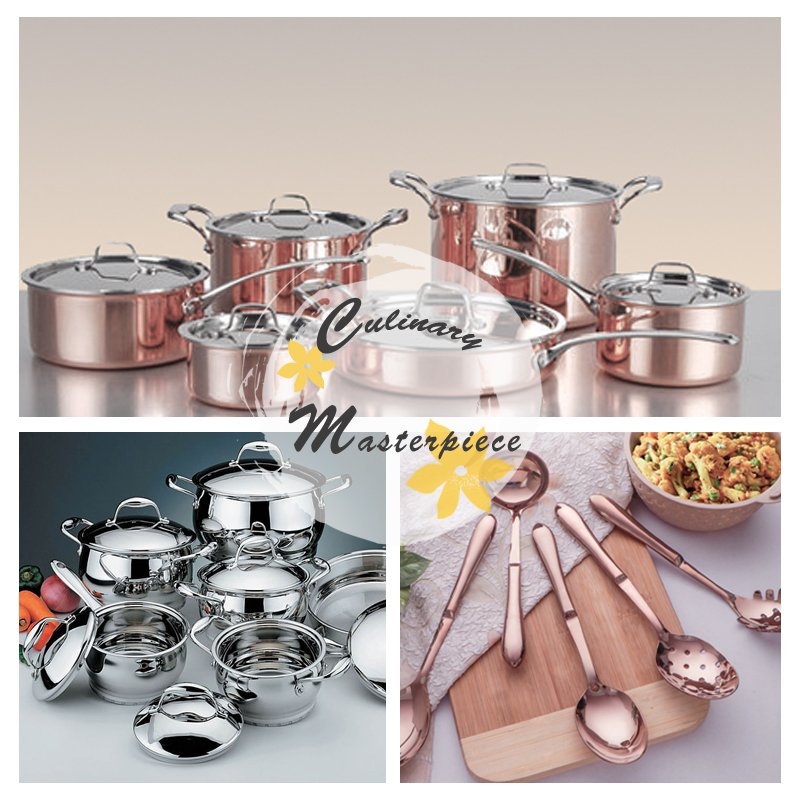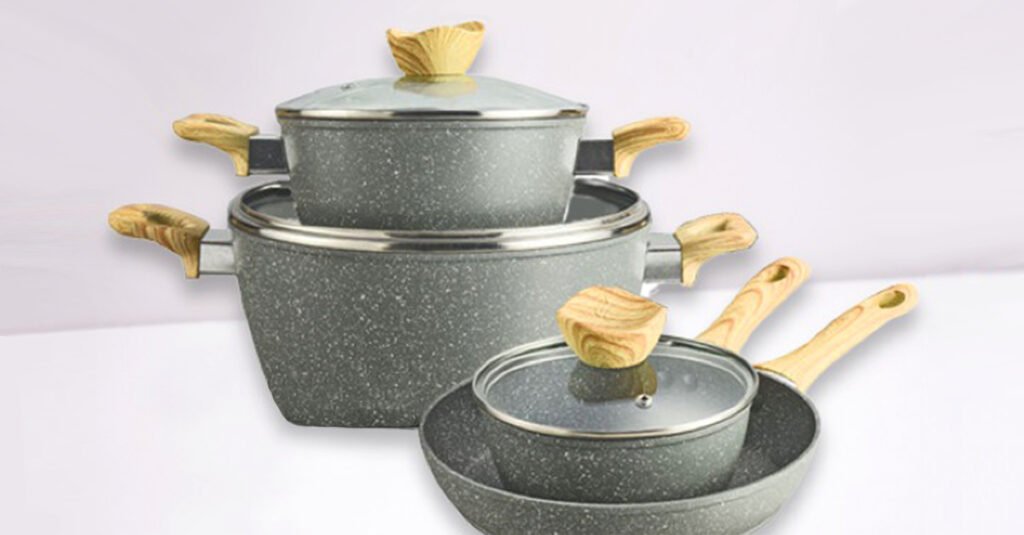Cookware Set: 10 Essential Tips for Choosing the Perfect One - The Ultimate Guide

How to choose a cookware set is an essential question that arises for everyone, whether a beginner or a seasoned chef who spends time in the kitchen. The right cookware can make all the difference in your culinary adventures. This comprehensive guide will walk you through ten essential tips to help you select the best cookware set for your needs, ensuring you make an informed and satisfying purchase.
- Understand Your Cooking Needs
Before exploring the many options, understand your cooking habits and needs. Consider these questions:
- How often do you cook?
- What types of dishes you like to prepare?
- Do you enjoy any specific cooking technique?
- stir-frying
- baking
- Slow-cooking?
Answering these questions will help you determine the types and quantities of cookware you’ll need, ensuring you choose a set that complements your cooking style.
- Know the Types of Cookware Materials
Cookware sets are made from various materials, each with its own pros and cons; here are the most common ones
- Stainless Steel
Pros: Durable, non-reactive, and resistant to rust and corrosion.
Cons: Poor heat conductivity (though often improved with an aluminum or copper core).
- Aluminum
Pros: Excellent heat conductivity, lightweight, and affordable.
Cons: Can react with acidic foods, which may affect flavor and appearance. Anodized aluminum is a safer, more durable option.
- Cast Iron
Pros: Adds iron to your diet, excellent heat retention, versatile (can go from stovetop to oven).
Cons: Heavy and can rust if not properly maintained, requires seasoning.
- Non-Stick
Pros: Requires less oil for cooking, easy to clean, and ideal for less calorie diet.
Cons: Less durable, can be scratched easily, and may release harmful chemicals if overheated.
- Copper
Pros: Excellent heat conductivity and precise temperature control.
Cons: Expensive, requires regular maintenance, and can react with citrus food stuff (lemon, tamarind).
- Evaluate the Cookware Set Components
A standard cookware set typically includes a variety of pots and pans in different sizes. Consider the following common pieces:
- Saucepan: Ideal for making sauces, boiling pasta, and reheating leftovers.
- Stockpot: Perfect for making soups, stews, and boiling large quantities of food.
- Skillet/Frying Pan: Essential for frying, searing, and sautéing.
- Sauté Pan: Similar to a skillet but with higher sides, great for sautéing and simmering.
- Dutch Oven: Versatile for braising, baking, and making large one-pot meals.

Choose a set that fits your cooking needs. For large groups, get bigger pots and pans. For one or two people, a smaller set will do.
- Consider the Cookware Set’s Compatibility with Your Stovetop
Not all cookware materials are compatible with every type of stovetop. Here’s a quick guide:
- Gas Stoves: Most cookware materials work well, but ensure good heat distribution to avoid hotspots.
- Electric Stoves: Flat-bottomed cookware works best to maintain consistent contact with the heating element.
- Induction Stoves: Requires magnetic cookware (cast iron, stainless steel with a magnetic base). Aluminum and copper will not work unless they have a magnetic base.
- Pay Attention to the Cookware’s Weight
Consider how heavy your cookware is—it affects how well it cooks and how easy it is to use. Heavier pots and pans, such as cast iron and thick stainless steel, hold heat better and cook food more evenly. But they can be hard to handle, especially if you’re not very strong or have trouble moving around. Lighter cookware, like aluminum, is easier to handle, but it might not cook as evenly or hold heat as well.
- Check the Quality of the Handles and Lids
High-quality handles and lids are crucial for safety and convenience. Look for the following features:
- Handles: Should be sturdy, heat-resistant, and securely attached. Riveted handles are generally more durable than welded ones.
- Lids: Should fit snugly to retain moisture and heat. Tempered glass lids are a popular choice as they allow you to monitor your cooking without lifting the lid, but they can be heavier and less durable than metal lids.
- Evaluate the Ease of Cleaning and Maintenance
Cookware that is easy to clean and maintain will save you time and effort in the long run. Non-stick surfaces are generally the easiest to clean, but they require gentle handling to avoid scratching. Stainless steel and cast iron require more maintenance but can offer superior cooking performance and durability.
Cleaning Tips by Material:
- Non-Stick: Avoid using metal utensils and harsh scrubbers. Hand wash with mild detergent.
- Stainless Steel: Use a stainless steel cleaner to remove stains and maintain its shine. It can typically be cleaned in the dishwasher.
- Cast Iron: Avoid soap; clean with hot water and a stiff brush. Dry thoroughly and re-season as needed to prevent rust.
- Assess the Cookware’s Durability and Longevity
Investing in a durable cookware set can save you money in the long run, as you won’t need to replace pieces frequently. Stainless steel and cast iron are known for their longevity, while non-stick coatings may wear out over time. Consider the manufacturer’s warranty as an indicator of the product’s durability.
- Determine Your Budget
Cookware sets come in a wide range of prices, from affordable options to high-end models. Determine your budget before you start shopping and look for the best quality within your price range. Remember, a higher initial investment in quality cookware can pay off in the long run through better performance and durability.
Budget-Friendly Tips:
- Consider buying individual pieces to build your set over time.
- Keep an eye out for sales and discounts, particularly during holiday seasons.
- Check reviews and ratings to ensure you’re getting good value for your money.
- Read Reviews and Seek Recommendations
Before you decide, read reviews and ask friends for advice. Reviews tell you how well the cookware works, how long it lasts, and if there are any problems. Look for common issues or good points.

Commonly asked Questions
- What is the safest Cookware Set?
The safest cookware sets are typically made from materials like stainless steel, cast iron, enamel-coated cast iron, and ceramic. These materials are durable, non-toxic, and do not leach harmful chemicals into your food.
Avoid cookware with non-stick coatings containing PFOA and PFAS, as they can release toxic fumes when overheated. Additionally, be cautious with aluminum cookware, as it may react with certain acidic foods and potentially leach aluminum into your meals.
Always follow manufacturer’s instructions for safe use and maintenance, including temperature limits and cleaning methods. Ultimately, the safest cookware set is one that meets your cooking needs, is made from high-quality materials, and is used and cared for properly.
- Which cookware set is good for health?
Cookware sets made from materials like stainless steel, cast iron, enamel-coated cast iron, and ceramic are generally considered good for health. These materials do not leach harmful chemicals into your food and are durable for long-term use.
In Conclusion choosing the right cookware is important for cooking well. Know what you need, learn about different materials, and think about things like weight, handles, and how easy it is to clean. Make sure it fits your stove too. Consider how strong it is, set a budget, and read reviews to help you decide.
Good cookware makes cooking better and more fun. With the right set, you can cook anything and enjoy making delicious meals. Happy cooking!
